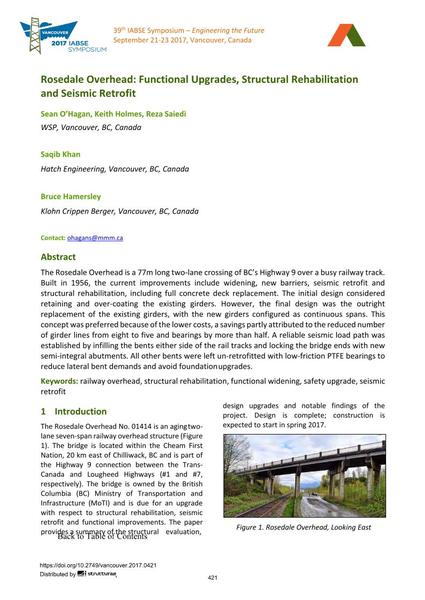Rosedale Overhead: Functional Upgrades, Structural Rehabilitation and Seismic Retrofit

|
|
|||||||||||
Bibliografische Angaben
| Autor(en): |
Sean O'Hagan
Keith Holmes (WSP, Vancouver, BC, Canada) Reza Saiedi (WSP, Vancouver, BC, Canada) Saqib Khan (Hatch Engineering, Vancouver, BC, Canada) Bruce Hamersley (Klohn Crippen Berger, Vancouver, BC, Canada) |
||||
|---|---|---|---|---|---|
| Medium: | Tagungsbeitrag | ||||
| Sprache(n): | Englisch | ||||
| Tagung: | IABSE Symposium: Engineering the Future, Vancouver, Canada, 21-23 September 2017 | ||||
| Veröffentlicht in: | IABSE Symposium Vancouver 2017 | ||||
|
|||||
| Seite(n): | 421-429 | ||||
| Anzahl der Seiten (im PDF): | 9 | ||||
| Jahr: | 2017 | ||||
| DOI: | 10.2749/vancouver.2017.0421 | ||||
| Abstrakt: |
The Rosedale Overhead is a 77m long two-lane crossing of BC’s Highway 9 over a busy railway track. Built in 1956, the current improvements include widening, new barriers, seismic retrofit and structural rehabilitation, including full concrete deck replacement. The initial design considered retaining and over-coating the existing girders. However, the final design was the outright replacement of the existing girders, with the new girders configured as continuous spans. This concept was preferred because of the lower costs, a savings partly attributed to the reduced number of girder lines from eight to five and bearings by more than half. A reliable seismic load path was established by infilling the bents either side of the rail tracks and locking the bridge ends with new semi-integral abutments. All other bents were left un-retrofitted with low-friction PTFE bearings to reduce lateral bent demands and avoid foundationupgrades. |
||||
| Stichwörter: |
Erdbebennachbemessung
|
||||
